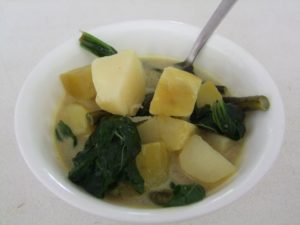 If you want to save money, you eat like the people of PNG do. That’s what we have been trying to do as much of as we can since we moved here to the “land of the unexpected”. 😛 It has been fun for me as the cook in our family to learn about what is available here and how to make the best use of it! At times it can be frustrating because I don’t know what I’m doing and it can be hard, but for the most part deciding, “What’s for dinner?” has been an invitation to adventure!
If you want to save money, you eat like the people of PNG do. That’s what we have been trying to do as much of as we can since we moved here to the “land of the unexpected”. 😛 It has been fun for me as the cook in our family to learn about what is available here and how to make the best use of it! At times it can be frustrating because I don’t know what I’m doing and it can be hard, but for the most part deciding, “What’s for dinner?” has been an invitation to adventure!
The entire process: buying local produce from the people and asking them questions about what their food is and how I should prepare it, to getting it to my sink and cutting board- I love it all.
Here is a bit of a peak into what it takes to make a very common PNG meal. Hopefully this will be the first of a few “PNG Kitchen” blogs and I hope you will enjoy seeing the kind of effort it takes to eat like the people here do.
Kaukau in Coconut Milk
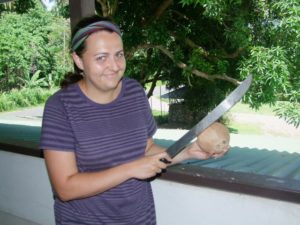 Step one: Get your “busnaip” (very large knife used for gardening and just about everything here in PNG) and break open your coconut. This is done by using the lower portion of your knife blade (technically you are supposed to use the back of the blade because it is safer that way but in this picture I forgot about that! Oops!) and smacking the side of the coconut very hard several times while turning it in your hand. You have succeeded when you hear a little “pop” sound and coconut water starts running out on your hands. 🙂
Step one: Get your “busnaip” (very large knife used for gardening and just about everything here in PNG) and break open your coconut. This is done by using the lower portion of your knife blade (technically you are supposed to use the back of the blade because it is safer that way but in this picture I forgot about that! Oops!) and smacking the side of the coconut very hard several times while turning it in your hand. You have succeeded when you hear a little “pop” sound and coconut water starts running out on your hands. 🙂
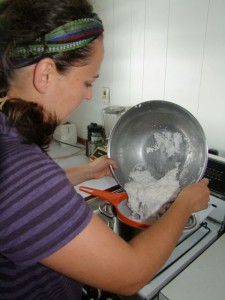 Step Two: Take your coconut halves to your “sikrap” (coconut scraper). Carefully scrape the inside of your coconut along the sharp teeth of the scraper and catch the shavings in a large bowl. This takes quite a bit of practice to do quickly and efficiently-I’m still working on it!
Step Two: Take your coconut halves to your “sikrap” (coconut scraper). Carefully scrape the inside of your coconut along the sharp teeth of the scraper and catch the shavings in a large bowl. This takes quite a bit of practice to do quickly and efficiently-I’m still working on it!
Step Three: Pour clean water (note: it’s NOT all clean here) over your freshly scraped coconut until it is shallowly covered. Squeeze the coconut with both hands to push the milk out of it into the water. When well squeezed, pour “milk” into cooking pot through a strainer. Repeat this squeezing process one more time to make sure you have ALL the goodness out of the coconut meat. Feed remaining coconut shavings to pigs and chickens. 🙂
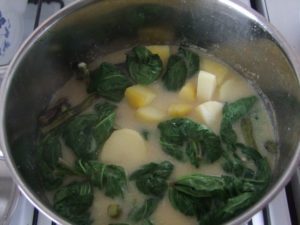 Step Four: Peel a few “kaukau” (similar to sweet potato that come in a variety of colors and textures) and dice into smallish pieces. Place into coconut milk and add a dash of salt and a dash of curry powder (this is a more expensive way to prepare it-many of the people here would not spice it). At this point you could also add some beans if wanted; I had some long beans, so I tossed those in too! Bring to a boil until kaukau is almost cooked through. Then add some “aipika” (local greens similar to spinach when cooked) after you have tied it in little knots. Continue boiling until aipika is cooked.
Step Four: Peel a few “kaukau” (similar to sweet potato that come in a variety of colors and textures) and dice into smallish pieces. Place into coconut milk and add a dash of salt and a dash of curry powder (this is a more expensive way to prepare it-many of the people here would not spice it). At this point you could also add some beans if wanted; I had some long beans, so I tossed those in too! Bring to a boil until kaukau is almost cooked through. Then add some “aipika” (local greens similar to spinach when cooked) after you have tied it in little knots. Continue boiling until aipika is cooked.
Step Five: Serve it, allow to cool and enjoy!
There you have it, now you can be a PNG chef just like I am!
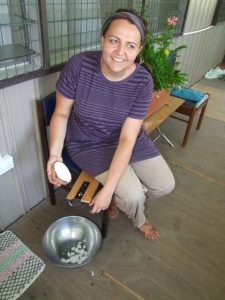
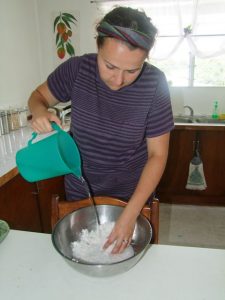
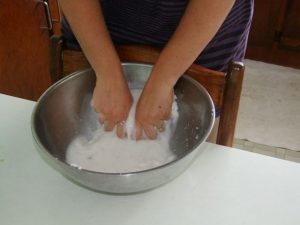
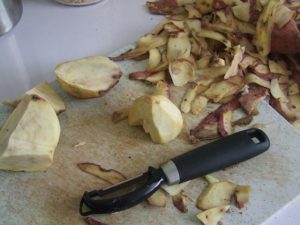
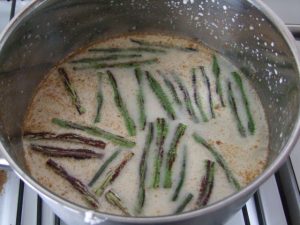
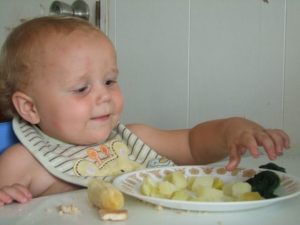
Shelley Hunt says
This is just proof that kids will eat anything!!!!
Deb says
I CANNOT wait for you to come home on furlough and make us some of that! It looks yummy!